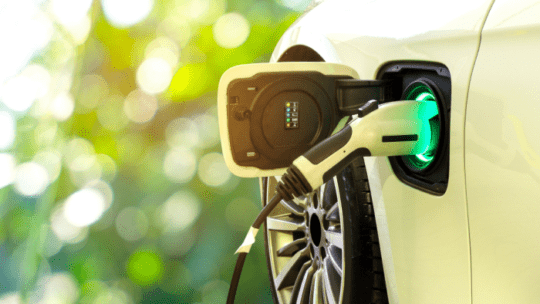
A generation ago, car shows provided entertainment on weekend afternoon. Owners of Ford Model T’s and Pontiac GTOs drove to parks or village downtown areas, allowing onlookers to gawk at former automotive brilliance.
Recently, in Princeton, N.J., a new type of car show surfaced. In partnership with NRG Energy, Sustainable Princeton celebrated eCommuter Fest, showcasing the latest carbon-free commuter technology. Activities included electric vehicle (EV) test drives from Toyota, Ford, Tesla, Zero Motorcycles and Polestar, as well as a local EV and eBike owner show.
People are always interested in transportation methods, but for the first time the automotive industry is hitting a tipping point on EVs.
A recent Bloomberg analysis of global EV adoption rates shows the U.S. is the latest nation to pass the 5% mark of new car sales whose sole power source is electricity. The 5% threshold signals a start to mass technology adoption, “the period when technological preferences rapidly flip,” Bloomberg says.
Tech advancements as well as concerns about climate change have moved American consumers toward accepting EVs. On the tech side is a "dramatic reduction in the cost of materials to manufacture" EVs, such as lithium-ion batteries, Bree Reynolds, account supervisor, Berlin Rosen, says.
Similarly, climate change's effects are increasingly visible. "Consumers are more aware of the need to change their behavior and have become more environmentally conscious in their purchasing decisions,” Reynolds adds.
An Audience Shift
Consumers have several reasons for considering EVs, including rising gas prices and climate change-related weather disasters. Communicators are gathering data on this rise in interest.
Recent Porter Novelli research studied sustainable actions consumers are willing to adopt. Its survey of 2,101 American adults in August revealed a big jump in what people will do to help the planet.
“For the first time in over 15 years, we have seen the number of people who are unconcerned about the planet fall to just 4%,” says Sandy Skees, a Porter Novelli EVP and global lead, purpose & impact. Previously, the figure was 10-20%. The 4% figure means “essentially all Americans are concerned about the state of the planet.”
Concerning EV adoption, the data showed:
- One-third of consumers (32%) were most likely to purchase automotive products that help protect the planet.
- Nearly half of consumers (46%) would drive an EV to help protect the planet.
In addition to more affordable EV prices, Skees sees interest rising because “selections have increased across multiple car brands and a steady drumbeat of media coverage about the build-out of charging stations (thanks to the Infrastructure bill) is beginning to assuage range anxiety.”
Another example of shifting consumer perspectives comes from The Purpose Power Index (2022), the first empirical measure of companies that activate purpose as the core of their business.
“The rise of electric vehicles is giving the automotive category a new sense of higher purpose," says Chip Walker, the Index study lead and StrawberryFrog head of strategy.
Speaking of purpose, Red Havas recently unveiled Red Impact, an offering that gives clients greater access to expertise in purpose and ESG.
Communicators Craft Educational Messages
The rise in consumer interest has catalyzed the need for greater promotion of EV and adjacent industries. “Clear and effective communication around EVs, chargers and related infrastructure [is vital] as we facilitate this monumental transition,” says Lesley Sillaman, EVP, Red Havas.
Reynolds agrees that not only startups, but legacy automotive companies in the EV space, need to drive home a unified message about adoption. That message includes statements that not only are EVs vehicles "affordable, accessible and reliable, but also a key part of creating a healthy and sustainable future for everyone."
Communication mandates include educating consumers who may be unclear about EV technology or how these vehicles fit their lifestyle. Key messages can address consumer concern with range anxiety, Reynolds says—an issue that centers on how far an EV can travel before it needs an additional electrical charge.
She recommends "speaking directly" with consumers and "avoiding jargon and marketing-speak." Moreover, Reynolds suggests utilizing the best industry experts to speak with media and work with marketing on messages that offer practical steps for consumers considering EVs.
And don't forget about using data. "For example, show that by switching to an EV consumers can save X dollars per year on gas or reduce their individual carbon footprint by X%," Reynolds says.
Communicators can also capitalize on newsjacking, as environmental and climate concerns continue to dominate news cycles. Examples include passage of legislation and new funding.
"As funding from the bipartisan infrastructure law begins to roll out, prepare to provide expert media commentary that speaks to broader industry trends and demonstrates how new technologies...will utilize this funding and advance the goals"...in the bill," she adds.
